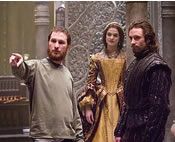
Hugh Jackman and Rachel Weisz in The Fountain
The Fountain has been showered with both praise and criticism since it premiered at Venice. It received a 10-minute ovation there but faced a rough ride at Cannes – now on general release in the UK, critics have heaped praise on the film.
But director Darren Aronofsky had a battle on his hands just to get the film made, after his original stars, Brad Pitt and Cate Blanchett, quit the production in 2002.
The 38-year-old says: “I started writing the film in 1999 – it began as a rough sketch on the back of a napkin in a restaurant – and we originally put together a big budget version of it.
“Then in September of 2002, when we were seven weeks from starting shooting, with $18 million spent, the lead actor quit and the film fell apart. They wrapped up the sets and I went home and for about seven months I tried to figure out what to do next and I started coming up with new ideas.”
But the Requiem For A Dream director refused to let go of the idea.
He adds: “I realised it was deep in my blood and I just had to tell this story. So I just started writing and I realised I didn’t have to write for a lead actor or for a studio, that I started out as a no-budget director and could write a no-budget version of this film. So I rewrote it and handed it to my producer and he said, you’ve turned it from a story into a poem and we can make it for half what we’d originally planned.”
Rachel Weisz – who later took on the central role of Izzi alongside Pitt replacement Hugh Jackman – says this dogged approach is typical of her fiance.
She says: “That’s Darren. I can’t think of another example of a person who would keep, you know... I’m not going to mention the names of the films that he was offered – Hollywood films - and he just said ‘No’ to every single one because this is what he wanted to do.
“It’s a testament to, I think, his passion and belief as an artist. Everybody said ‘No’ many, many, many, many, many times. He just kept biting. He doesn’t really go with the herd. He does his own thing.”
In this case, doing his own thing meant creating a massive epic, spanning an entire millennia – stretching from 16th Century Spain to 26th Century outer space.
But Aronofsky doesn’t think the story is too complex – although he reckons a repeat viewing may be needed to get the most from it.
He says: “It’s a really simple story in fact. At its heart it’s a love story between a man and a woman, except there’s a tragedy happening, which is that the woman is dying at too young an age. And the man feels that he has to fix the problem, to find a cure while this woman is starting to realize that she’s not going to make it and is beginning to open up to the infinite possibilities of what might happen when you die. So she writes a book about a conquistador and a queen that is a metaphor for their experience and what’s going on.
 |
| Darren Aronofsky with Rachel and Hugh on the set |
“I hope people will see the film a second time and see a whole other layer of meaning. I mean, we sat around for five years trying to make the story denser and denser, more and more complex.”
And Aronofsky says universal themes of mortality are important to consider and says it’s a failing of Western society that we don’t think about it more.
He says: “I think it’s part of growing up to start thinking about death. There are certain cultures where death is sort of incorporated into life but I think that in this culture all we’re trying to do is run away from death and aging.
“Just look at the popularity of shows like Nip/Tuck or Extreme Makeover. People are praying to be young and hospitals spend huge amounts of money trying to keep patients alive, however old, rather than allowing them to die with dignity. So I think one of the central themes of the film is just that: Does death make us human, and if we could live forever, would we lose our humanity?
“I hope people who like to be challenged and want to see a film that they’ll still be thinking about the day after seeing it will give it a chance.”





















